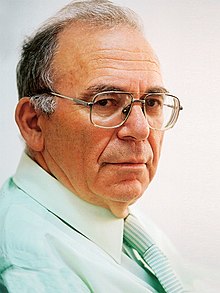네헤미아 레프치온
Nehemia Levtzion네헤미아 레프치온 | |
|---|---|
נחמיה לבציון | |
 네헤미아 레프치온 | |
| 태어난 | 1935년 11월 24일 |
| 죽은 | 2003년 8월 15일 (67세) |
| 국적 | 이스라엘의 |
| 제목 |
|
| 아이들. | 4 |
Nehemia Levtzion (Hebrew: נחמיה לבציון; November 24, 1935 — August 15, 2003) was an Israeli scholar of African history, Near East, Islamic, and African studies, and the President of the Open University of Israel from 1987 to 1992 and the Executive Director of the Van Leer Jerusalem Institute from 1994 to 1997.[1]
초기 및 개인 생활
레프치온은 베어 투비아의 모샤브에서 태어났다.[1] 그의 부모는 페니나(네 페를로우)와 아론 루베츠키(아론 루베츠키)로, 후에 레프치온으로 성을 바꾸었고, 그에게는 한나라는 누나가 있었다.[1] 그는 유대인이었고, 네 명의 자녀를 두었다.[2] 그의 아내 티르차는 예루살렘에 있는 Gymnasia Rehavia 고등학교의 교사와 부교장이었다.[3] 그들은 한때 가나에서 살았고, 그곳에서 그는 아프리카의 이슬람의 확산을 연구했다.[3] 그 가족은 예루살렘의 베이트 하크렘에도 살았다.[3] Levzion은 1965년 런던 대학에서 논문을 완성했다.[4]
경력
레프치온은 아프리카 역사, 근동, 이슬람, 아프리카 학자들, 특히 아프리카의 이슬람 학자들이다.[3][5] He taught at (starting in 1965) and was Professor of History and Asian and African Studies and the Dean of the Faculty of Humanities (1978-1981) at the Hebrew University of Jerusalem, the Director of the Ben-Zvi Institute for the Study of Jewish Communities in the East (1982-1987), the President of the Open University of Israel (1987-1992), the Ex반 리어 예루살렘 연구소장(1994-1997)과 이스라엘의 계획 및 예산 위원회 고등 교육 위원회 위원장(1997-2003년)의 선임 이사.[2][6][3]
네헤미아 레프치온 회교연구센터는 2004년 예루살렘 히브리 대학에 설립되었다.[7]
선택한 게시물
- Levtzion, Nehemia (1969). Muslims and Chiefs in West Africa: A Study of Islam in the Middle Volta Basin in the Pre-Colonial Period. Oxford University Press. p. 228.[8][9]
- Levtzion, Nehemia (1973). Ancient Ghana and Mali. Methuen and Company. p. 283.[10]
- Levtzion, Nehemia, ed. (1979). Conversion to Islam. Holmes and Meier. p. 272.[11]
- Levtzion, Nehemia; Fisher, Humphrey J., eds. (1987). Rural and Urban Islam in West Africa. Lynne Rienner Publishers. p. 176.[12]
- Levtzion, Nehemia; Voll, James O., eds. (1987). Eighteenth-Century Renewal and Reform in Islam. Syracuse University Press. p. 200.[13]
- Levtzion, Nehemia (1994). Islam in West Africa: Religion, Society and Politics to 1800. Ashgate Publishing. p. 324.[14][15]
- Levtzion, Nehemia; Pouwels, Randall L. (2000). The History of Islam in Africa. Ohio University Press. p. 592.[16][17]
- Levtzion, Nehemia (2007). Abitbol, Michel; Nadan, Amos (eds.). Islam in Africa and the Middle East: Studies on Conversion and Renewal. Ashgate/Variorum. p. 336.[18]
추가 읽기
- McDougall, E. Ann, Ed.(2014). 레거시 활용: 네헤미아 레프치온(1935-2003). 루틀리지. ISBN 978-1-317-98090-2
참조
- ^ Jump up to: a b c "The Legacy of Nehemia Levtzion 1935-2003". Canadian Journal of African Studies. 42 (2/3): 230–249. 2008. doi:10.1080/00083968.2008.10751379. JSTOR 40380164. S2CID 219565300.
- ^ Jump up to: a b "네헤미아 레프치온; 1935—2003," 수단 아프리카, 14, 2003, 21-32.
- ^ Jump up to: a b c d e Judy Siegel-Itzkovich (September 10, 2017). "Dr. Levtzion-Korach is first female to run a state-owned general hospital". The Jerusalem Post.
- ^ Wilks, Ivor (2008). "Nehemia Levtzion and Islam in Ghana: Reminiscences". Canadian Journal of African Studies. 42 (2–3): 250–264. doi:10.1080/00083968.2008.10751380. S2CID 148738309.
- ^ McDougall, E. Ann (2008). "Engaging with the Legacy of Nehemia Levtzion: An Introduction". Canadian Journal of African Studies. 42 (2/3): 213–229. doi:10.1080/00083968.2008.10751378. JSTOR 40380163. S2CID 219565283.
- ^ "Nehemia Levtzion". Ohio University Press / Swallow Press.
- ^ "이슬람 연구를 위한 네헤미아 레프치온 센터"
- ^ Hunwick, J. O. (October 1969). "Muslims and Chiefs in West Africa: a study of Islam in the Middle Volta Basin in the pre-colonial period". African Affairs. 68 (273): 363–364. doi:10.1093/oxfordjournals.afraf.a095936.
- ^ Brenner, Louis (April 1971). "Nehemia Levtzion. Muslims and Chiefs in West Africa: A Study of Islam in the Middle Volta Basin in the Pre-Colonial Period. (Oxford Studies in African Affairs.) New York: Oxford University Press. 1969. Pp. xxvi, 228. $7.00". The American Historical Review. 76 (2): 533–534. doi:10.1086/ahr/76.2.533-a.
- ^ Fagan, Brian M. (April 1975). "Nehemia Levtzion. Ancient Ghana and Mali. (Studies in African History, 7.) London: Methuen and Company; distrib. by Barnes and Noble, New York. 1973. Pp. x, 283. Cloth $10.00, paper $6.50". The American Historical Review. 80 (2): 448–449. doi:10.1086/ahr/80.2.448.
- ^ Stewart, C. C. (October 1980). "Conversion to Islam. Edited by Nehemia Levtzion. New York: Holmes and Meier, 1979. Pp. viii + 272. $29.50". The Journal of African History. 21 (4): 570–571. doi:10.1017/S0021853700018910.
- ^ Ibrahim, Jibrin (December 1990). "Rural and Urban Islam in West Africa edited by Nehemia Levtzion and Humphrey J. Fisher Boulder and London, Lynne Rienner Publishers, 1987 edn. Pp. vii + 176. £20.95". The Journal of Modern African Studies. 28 (4): 715–716. doi:10.1017/S0022278X00054884.
- ^ Brett, Michael (June 1989). "Nehemia Levtzion and John o. Voll, editors. Eighteenth-Century Renewal and Reform in Islam. Syracuse, N.Y.: Syracuse University Press. 1987. Pp. 200. $24.95". The American Historical Review. 94 (3): 822–823. doi:10.1086/ahr/94.3.822.
- ^ Hawting, G. R. (June 1995). "Nehemia Levtzion: Islam in west Africa: religion, society and politics to 1800. (Collected Studies Series, CS462.) x, [324] pp. Amersham Hants.: Variorum; Brookfield, Vermont: Ashgate Publishing Co., 1994. £49.50". Bulletin of the School of Oriental and African Studies. 58 (2): 435–436. doi:10.1017/S0041977X00011654.
- ^ Bangura, Ahmed Sheikh (1997). "Islam in West Africa: Religion, Society and Politics to 1800 (by Nehemia Levtzion) (Book Review)". American Journal of Islamic Social Sciences. 14 (3): 91–92. doi:10.35632/ajis.v14i3.2271.
- ^ Mirzeler, Mustafa (2001). "The History of Islam in Africa (review)". Africa Today. 48 (2): 168–170. doi:10.1353/at.2001.0039. S2CID 143048787.
- ^ Reese, Scott (October 2004). "Book Review: The History of Islam in Africa". Journal of Asian and African Studies. 39 (5): 456–458. doi:10.1177/002190960403900516. S2CID 143536672.
- ^ Last, Murray (May 2008). "Islam in Africa and the Middle East: Studies on Conversion and Renewal BY NEHEMIAH LEVTZION. Edited by MICHEL ABITBOL and AMOS NADAN". Journal of Islamic Studies. 19 (2): 268–269. doi:10.1093/jis/etn017.


